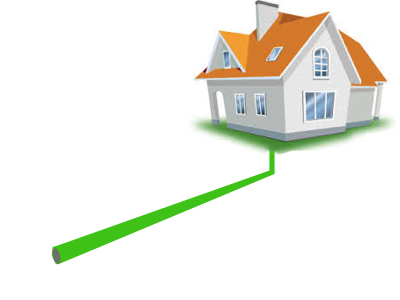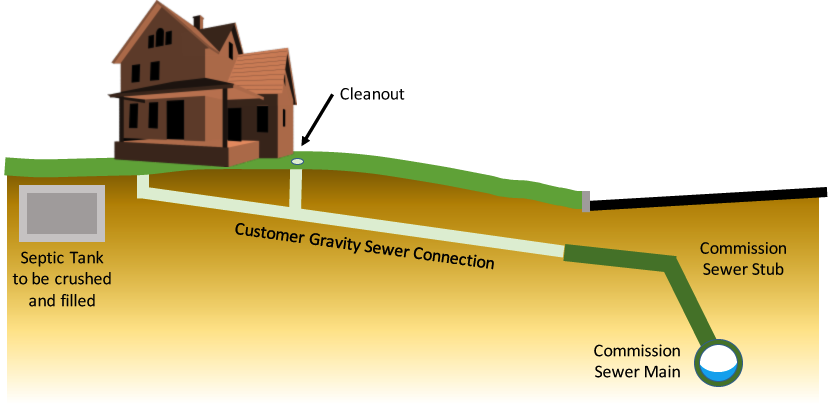Step 4: Attend a Commission meeting for permit approval
Permits for new properties require special approval and are typically approved every two weeks at the commission meeting. It is strongly recommended that the applicant personally come to the Commission meeting to discuss the permit so that the Commission can be well informed before voting on the approval.
Once an approval occurs the LSDC will send an email to the applicant noting that the permit was approved and that arrangements for construction can begin. Applicants who do not provide an email address must call the LSDC’s office to confirm that the permits were approved.
Step 5: Hire a Contractor and get a cost estimate
Property owners will find that hiring a Licensed Drainlayer to assist from the beginning on will help tremendously. Although you can wait until you have all approvals in hand you will find that professionals who work regularly with the LSDC understand the connection process and can assist you with the permitting.
For those who have a typical connection - a gravity connection with easy access to service stub in street, no indoor plumbing issues, etc., we recommend that you call three or more drainlayers from our licensed contractor list to discuss the work and provide you with a cost estimate. Make sure that you fully understand the service they are providing.
Typically, drainlayers will provide permitting assistance, materials and labor, removal of the old septic system, and restoration of your property. They will also be able to advise you of any site or plumbing issues that could complicate your connection process. More complicated connections may require the assistance of a professional engineer.
Step 6: Review construction plan
Most services connections can be constructed in a day or two. The progression of works typically starts with exposing the Commission's sewer connection stub at the street line and the residential sewer pipe at the house. A trench is then excavated between the two and a PVC sewer pipe is layed in a bed of crushed stone and sand. A cleanout will need to be installed near the house foundation so that any clogs that may occur in future can be easily cleared. In certain cases, where the property sits low compared to the street or ina low-pressure sewer area, your sewer connection will need a grinder pump to get to the sewer main.
Once the sewer connection is installed between the house and the street the final plumbing connection is made and the old septic tank is pumped out and crushed in place and covered over. The LSDC’s inspector will spot-inspect critical steps along the way for compliance.
Connect a New Home or Business
The Lancaster Sewer District Commission knows that the connection of your property to the Commission's sewer can be a large investment that deserves careful consideration. This step-by-step guide for connecting newly constructed homes and businesses in our service area will help you through the process and answer any questions you may have.
If you are trying to connect an existing home or business with a failed septic system please review our guide to connecting existing properties. If you are planning on connecting a development or subdivision please review our development guide.
Please don’t hesitate to contact us and we’ll be happy to assist you with any questions.
Step 1: Determine the sewer capacity flow credits needed to connect
Step 2: Prepare and submit permits
Step 3: Determine Sewer Entrance Charge in Lieu of Assessment
Step 4: Attend a Commission meeting for permit approval
Step 5: Hire a contractor and get a construction estimate
Step 6: Review construction plan
Step 7: Schedule construction and inspection

Step 1: Determine the sewer capacity flow credits needed to connect
Any connection that is not replacing a failed septic system will need to obtain sewer capacity flow credits from the Sewer Bank in order to connect. The sewer bank is a “bank” of sewer capacity flow credits used by the LSDC to allow new connections which would otherwise be required to fix infiltration and inflow leaks in the District's system first. To determine the capacity needed, download the DEP Title 5 Flow Charts and calculation sheet and determine the amount of flow you will be adding to the system. All issuances of sewer capacity flow credits from the Sewer Bank need Commission approval and you will need to know this number when you discuss your proposed connection. If you are instead connecting a property with a failed septic system please review our guide for existing properties.
Step 2: Determine Sewer Entrance Charge in Lieu of Assessment
New properties may be subject to a Sewer Entrance Charge in Lieu of Assessment. This type of charge is for properties that were not previously charged a betterment or were not part of a development built under a sewer extension permit.
An example of when this charge would apply is if a large property split into two or more smaller properties several years after a betterment was assessed. The original property was assessed a single betterment but the new properties that were split from the original were not charged a betterment. These new properties would be subject to this charge.
If the property was already assessed a betterment or is part of a development built under a sewer extension permit then this fee will not apply.
The charge is equal to the betterment fee applied to adjacent properties or at the minimum charge set by the Commission. If required, this charge is calculated as part of the permit application process described in Step 3.
Step 3: Prepare and submit permits
Download and complete the LSDC Service Connection Application Multiform. If the installation is unusual or triggers a special permit category please additionally be sure that any site plans are submitted in accordance with our Site Plan Submission requirements. The owner, or owners representative, will submit the full permit package to the LSDC for review. Be sure that your payment for all permit costs is attached to the submission. Sewer connection permits do not authorize other permits that may be required such as street opening permits and wetlands permits.
Step 7: Schedule construction and inspection
At least 48 hours in advance of the commencement of construction the contractor must arrange for inspection with the LSDC Inspector. There are no exceptions to this rule. The LSDC must inspect the connection or it will be ordered removed.
Upon request, the LSDC will provide a certificate of compliance once the connection has been completed and inspected. This certificate serves to demonstrate to lenders and others that the connection was made in accordance with the LSDC’s standards.

Typical Sewer Connection
